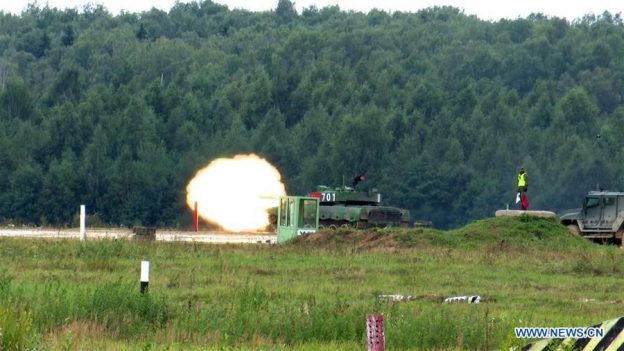The New York Analysis of Policy & Government continues its excerpts from the new China Military Power 2020 report
The PLA’s objective is to become a “world-class” military by the end of 2049—a goal first announced by General Secretary Xi Jinping in 2017. Although the CCP has not defined what a “world-class” military means, within the context of the PRC’s national strategy it is likely that Beijing will seek to develop a military by mid-century that is equal to—or in some cases superior to—the U.S. military, or that of any other great power that the PRC views as a threat. As this year’s report details, the PRC has marshalled the resources, technology, and political will over the past two decades to strengthen and modernize the PLA in nearly every respect. Indeed, as this report shows, China is already ahead of the United States in certain areas such as:
- Shipbuilding: The PRC has the largest navy in the world, with an overall battle force of approximately 350 ships and submarines including over 130 major surface combatants. In comparison, the U.S. Navy’s battle force is approximately 293 ships as of early 2020.
- Land-based conventional ballistic and cruise missiles: The PRC has more than 1,250 groundlaunched ballistic missiles (GLBMs) and ground-launched cruise missiles (GLCMs) with ranges between 500 and 5,500 kilometers. The United States currently fields one type of conventional GLBM with a range of 70 to 300 kilometers and no GLCMs.
- Integrated air defense systems: The PRC has one of the world’s largest forces of advanced longrange surface-to-air systems—including Russian-built S-400s, S-300s, and domestically produced systems—that constitute part of its robust and redundant integrated air defense system architecture.
More striking than the PLA’s staggering amounts of new military hardware are the recent sweeping efforts taken by CCP leaders that include completely restructuring the PLA into a force better suited for joint operations, improving the PLA’s overall combat readiness, encouraging the PLA to embrace new operational concepts, and expanding the PRC’s overseas military footprint.
UNDERSTANDING CHINA’S STRATEGY
China’s National Strategy
The People’s Republic of China’s (PRC’s) strategy aims to achieve “the great rejuvenation of the Chinese nation” by 2049. China’s strategy can be characterized as a determined pursuit of political and social modernity that includes far-ranging efforts to expand China’s national power, perfect its governance systems, and revise the international order.
The Chinese Communist Party (CCP) frames this strategy as an effort to realize long-held nationalist aspirations to “return” China to a position of strength, prosperity, and leadership on the world stage. > The CCP’s leadership has long viewed China as embroiled in a major international strategic competition with other states, including, and in particular, the United States.
In 2019, China intensified its efforts to advance its overall development including steadying its economic growth, strengthening its armed forces, and taking a more active role in global affairs.
Foreign Policy
The PRC’s foreign policy seeks to revise aspects of the international order on the Party’s terms and in accordance with ideas and principles it views as essential to forging an external environment conducive to China’s national rejuvenation.
In 2019, the PRC recognized that its armed forces should take a more active role in advancing its foreign policy, highlighting the increasingly global character that Beijing ascribes to its military power.
Economic Policy
The CCP prioritizes economic development as the “central task” and the force that drives China’s modernization across all areas, including its armed forces.
China’s economic development supports its military modernization not only by providing the means for larger defense budgets, but through deliberate Party-led initiatives such as OBOR and Made in China 2025, as well as the systemic benefits of China’s growing national industrial and technological base.
Military-Civil Fusion (MCF) Development Strategy.
The PRC pursues its MCF Development Strategy to “fuse” its economic and social development strategies with its security strategies to build an integrated national strategic system and capabilities in support of China’s national rejuvenation goals.
MCF encompasses six interrelated efforts: (1) fusing the China’s defense industrial base and its civilian technology and industrial base; (2) integrating and leveraging science and technology innovations across military and civilian sectors; (3) cultivating talent and blending military and civilian expertise and knowledge; (4) building military requirements into civilian infrastructure and leveraging civilian construction for military purposes; (5) leveraging civilian service and logistics capabilities for military purposes; and, (6) expanding and deepening China’s national defense mobilization system to include all relevant aspects of its society and economy for use in competition and war.
While MCF has broader purposes than acquiring foreign technology, in practice, MCF means there is not a clear line between the PRC’s civilian and military economies, raising due diligence costs for U.S. and global entities that do not desire to contribute to the PRC’s military modernization.
The report continues tomorrow.
Photo: On August 9, a Y-20 military transport aircraft of the PLA Air Force flew from the Shenyang Taoxian International Airport to Russia with a flight of over 7,600 km, carrying a total of 57 soldiers from the PLA Northern Theater Command to participate in the International Army Games 2020. (China Defense Ministry)
